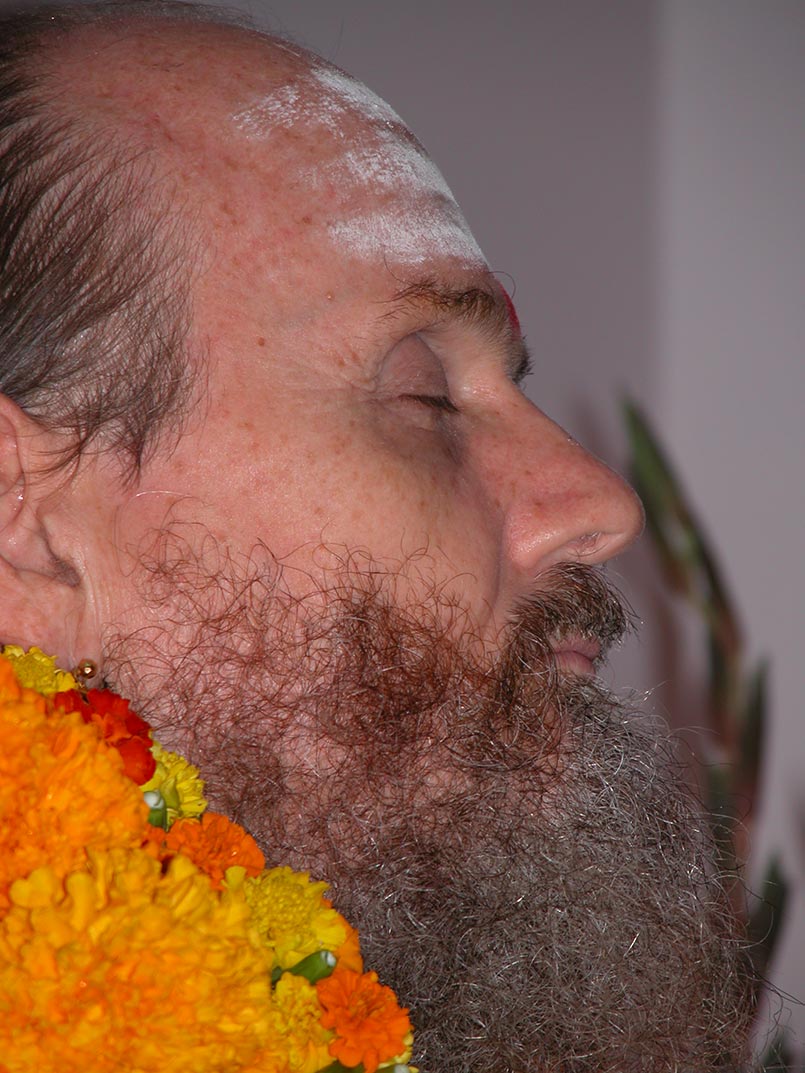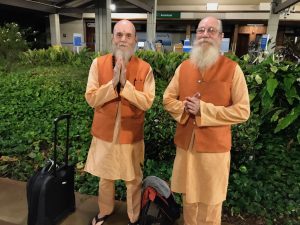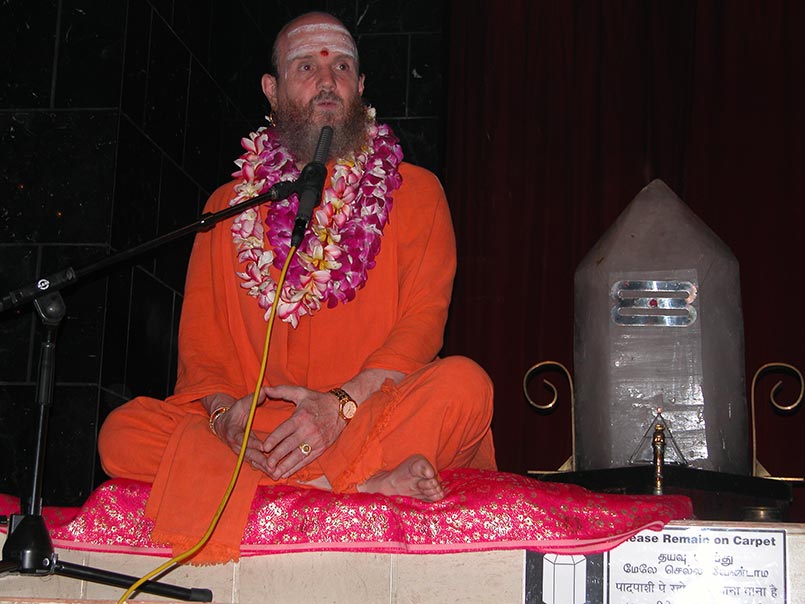Why Do We Practice Ahimsa?
Satguru Bodhinatha Veylanswami reads from Lesson 48 of the Himalayan Academy publication “Path To Siva,” discussing the practice of “ahimsa” or non-violence in thought, word and deed.
Bodhinatha Returns
Satguru's tour around the world is over for now. The monks welcome him and Shanmuganathaswami back home with a short pada puja and arati, first to him and then for him in Kadavul temple.
How Do We Meditate, Part 2

Bodhinatha's Latest Upadeshas
Path to Siva Commentaries
How Do We Meditate, Part 2
"Adjust yourself to the realization that you are a divine being, a self-effulgent, radiant being of light."
Jyoti is the Sanskrit word for inner light. To bestow on devotees terms that were more specific, Gurudeva developed the Shum Language of Meditation. In Shum the word for the light that lights up the mind is balikana. During Shum meditation there is an indrawing of forces to realize balikana, a moon-like glow, leading to iftye a deeper kind of inner light which, in turn, leads to milinaka, a sustained iftye which doesn't go away and can be sustained after we've finished our meditation.
Path to Siva, Lesson 47
Twelve Shum Meditations
Click here to go to an index of all of Bodhinatha's and Gurudeva's online audio.
Satguru Travels the World in 18 Days

2018 Sri Lanka Innersearch – Class 4
Satguru Bodhinatha Veylanswami gives his forth class during the 2018 Innersearch Sri Lanka travel-study program.
How Do We Meditate, Part 1

Bodhinatha's Latest Upadeshas
Path to Siva Commentaries
How Do We Meditate, Part 1
"Meditation is a long journey, a pilgrimage into the mind itself." In Gurudeva's approach we start meditation with the physical body then get more and more subtle, withdrawing energy into the spine then not utilizing mental activity. Everything we meditate on is actual experience, not something the mind has created. We experience something that's always there, awareness aware of itself. Gurudeva's mystical Natha Language of Shum. Awareness is the witness consciousness of the soul, 'niif.' In the nature of our form of meditation there is a continuity (nalif) from one day to the next.
Path to Siva, Lesson 47.
Click here to go to an index of all of Bodhinatha's and Gurudeva's online audio.
2018 Sri Lanka Innersearch Class 3
Satguru Bodhinatha Veylanswami gives his third class during the 2018 Innersearch Sri Lanka travel-study program.
How Do We Meditate? – Part 2
Satguru Bodhinatha Veylanswami reads from Lesson 48 of the Himalayan Academy publication “Path To Siva,” discussing how we approach the fine art of meditation.
Our Link to a Natha Siddhar

Satguru Bodhinatha recently came back from malaysia, and while he was there he visited the samadhi shrine of Natha siddhar Swami Jaganatha in the town of Tapah, where there is currently a renovation going on. We are connected to Swami in a mystical way, and we wrote about it in Hinduism Today in 1987.
Our slideshow today contains a blogpost from http://agathiyarvanam.blogspot.com/2013/07/jeganatha-swamigal-jeganatha-swamigal.html
The short article from Hinduism Today is below:
Swami Jaganatha was born in Puri, India, two years after the American War of 1812-a time when the British were establishing a mercantile beachhead in India. He died 145 years later, in 1959, in the emerald jungles of Tapah, Malaysia-his physical home a small, rude hut far from civilization, his spiritual home the infinite realms of Siva consciousness.
He lived in Tapah some 78 years, originally migrating out of India to Burma when he was 18, performing body-numbing tapas (austerities to accelerate soul unfoldment) and finally crossing into Malaysia in his late 60's. Swami Jaganatha was a siddha par excellence of the Natha Sampradaya (tradition of the Siva masters). He left a legacy of pinnacle spiritual achievement for all Malaysia Hindus and a posthumous prophecy of international scope that bore true. Few knew him personally. He mainly strode the corridors of our dream-world, the realities of the Devaloka surrounding this planet.
Finding him was difficult enough even if he inwardly wanted to see you. And the jungle and Japanese soldiers in occupation kept the fainthearted away. But some came. And if they could stand the tests of their own mind they followed Jaganatha as Sat Guru. One such earnest seeker was K.S. Gurusamy Pillai.
Gurusamy Pillai recounts his first meeting: "Some people commented, 'Why do you want to meet the madman who goes about dressed only in a loin cloth and always mumbling to himself!' The hut was almost completely grown over with vines and creepers. The swami asked me to first thank the man who had called him a madman. I sat on a low table. Then swami locked the door. Soon after, the swami disappeared and a cobra descended from the ceiling hissing loudly and, strangely, the hissing sounded like Aum. I was in great fear. Then the swami appeared, and the snake coiled back up to the roof and out of sight."
Three months later Gurusamy Pillai revisited Jaganatha. The swami asked Pillai to write to a close disciple in Sri Lanka telling him to go see Yogaswami (a renowned Sat Guru of the Natha Sampradaya who died in 1964). Then Jaganatha predicted another "soul" from America called Subramuniya would come. "He would reside in Hawaii. Subramuniya will travel around the world and everyone will receive his darshan. Then I, too, will join him," the swami declared. And indeed Sivaya Subramuniya, born in America, look Yogaswami as his guru, founded Saiva Siddhanta Church (headquarters in Hawaii) and travels annually from the West to the East.
How Do We Meditate?
Satguru Bodhinatha Veylanswami reads from Lesson 48 of the Himalayan Academy publication "Path To Siva," discussing how we approach the fine art of meditation.
From Our Gurus' Teachings
Archives are now available through 2001. Light colored days have no posts. 1998-2001 coming later.
